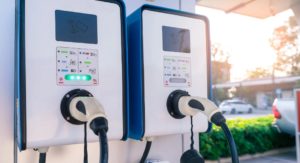For UK businesses, shifting to an electric fleet is no longer just a consideration but a strategic move offering heaps of advantages. However, going through the whole transitioning process still seems like a big pill to swallow. So, to ease in, here is our step-by-step guide to transitioning your business fleet to EVs.
A Step-by-Step Guide on Replacing Your Business Fleet With EVs
Switching your fleet over to EVs demands careful strategy and planning. Follow this step-by-step guide to sail through this process seamlessly.

Step 1: Fleet Assessment
Start by thoroughly evaluating your existing fleet, analysing each vehicle’s usage patterns, and deciding which can be replaced with EVs. It’s recommended that you consider these things during your assessment.
- Daily Mileage Requirements: What is your vehicle’s usual range? Since electric vehicles have varying ranges, it’s important to choose models that can meet your mileage requirements without giving your staff range anxiety.
- Cargo Space Needs: Switching to electric vehicles shouldn’t hamper business-related activities that involve moving your cargo or passengers.
- Vehicle Usage Patterns: Consider what your cars are used for on a day-to-day basis. For instance, if they are mainly driven within the city for short trips, then EVs are the best use case. However, if they are driven for long distances, you might want to go with hybrid options – EV + Gas – to get extra mileage.
Step 2: Develop a Charging Infrastructure Plan
Next, you will have to plan your charging infrastructure based on the above requirements. There are mainly two options for businesses in this regard:
- Workplace Charging Stations: These on-site stations make it easy for your staff members to plug in their EVs during work.
- Public Charging Networks: You can also use already established public charging stations as part of your charging strategy. But you have to be cautious, as relying solely on public charging stations can present challenges of its own. Research the availability and accessibility of charging stations along your usual routes to ensure the smooth running of the overall fleet.
Step 3: Securing Funding for EVs & Charging Stations

There are multiple options when it comes to securing funds for your EV fleet transition in the UK, with the highlights being the following:
- Leasing: Leasing out EVs could be an attractive option for businesses that want to reduce upfront costs while accessing the latest EVs. Lease payments are typically lower than loan payments for purchasing a vehicle, and they often cover maintenance costs. This can help with budgeting and keeping your fleet current.
- Salary Sacrifice Scheme: Salary sacrifice schemes, offered by companies such as loveelectric, let employees make a monthly pre-tax contribution towards leasing an electric vehicle. Such contributions lower employees’s taxable income and therefore decrease their monthly salary deductions, which in turn makes EVs affordable to them while at the same time offering tax incentives to employers.
- Government Grants and Subsidies: The UK government issues several grants and subsidies aimed at assisting organisations to meet the initial costs of buying new electric vehicles as well as installing charge points. All administration pertaining to these subsidies is done through the Office for Zero Emission Vehicles (OZEV).
- Workplace Charging Scheme (WCS): This scheme provides funding for businesses that want charging points for EVs at their work premises. It covers up to 75% of each socket’s purchase and installation cost, with a maximum cap of £14k per business and £350 per socket.
Step 4: Choose Your Electric Vehicles
Once you have identified your needs clearly and acquired the necessary funding, you can then move on to select electric vehicles that best suit your fleet based on other factors, like:
- Range
- Cargo Space & Passenger Capacity
- Technology & Features
- Total cost of ownership (TCO)
Step 5: Implement & Monitor
With the money sorted and EVs ready to roll, it’s the time when rubber meets the road for a full-tilt transformation. All that is left at this point is to monitor and optimise the performance of your EV fleet. There are four aspects to keep an eye on during this stage.
- Energy Consumption: Track energy consumption patterns for each vehicle and identify areas to cut costs.
- Charging Infrastructure Upgrades: Changes in demand patterns or the size of your fleet might require you to upgrade and optimise your charging infrastructure.
- Gather Employee Feedback: Get feedback from employees continuously regarding their experience with electric vehicles (EVs). The feedback can help you identify gaps that need improvement and ensure a smooth transition to EVs for everyone involved.
You can seamlessly go through the process of replacing your business fleet with EVs by following these steps.
Author Profile

- Blogger by Passion | Contributor to many Business Blogs in the United Kingdom | Fascinated to Write Blogs in Business & Startup Niches |
Latest entries
 BusinessDecember 12, 2025The Smart SME’s Guide to Future-Proofing Physical Assets
BusinessDecember 12, 2025The Smart SME’s Guide to Future-Proofing Physical Assets FinanceOctober 28, 2025How to Measure the ROI of Your Promotional Product Campaigns?
FinanceOctober 28, 2025How to Measure the ROI of Your Promotional Product Campaigns? Home & LivingOctober 4, 2025Moving Forward When Leicester Family Dynamics Change
Home & LivingOctober 4, 2025Moving Forward When Leicester Family Dynamics Change BusinessSeptember 22, 2025Always-On SMEs: The UK Business Owner’s Guide to Seamless Travel Data for Sales Trips, Trade Fairs & Remote Teams
BusinessSeptember 22, 2025Always-On SMEs: The UK Business Owner’s Guide to Seamless Travel Data for Sales Trips, Trade Fairs & Remote Teams





